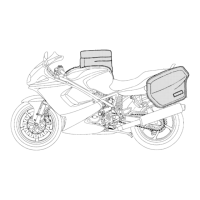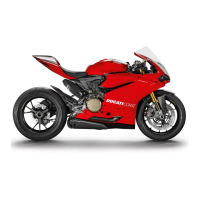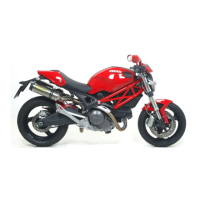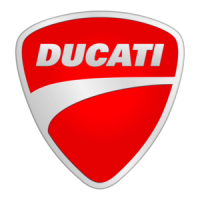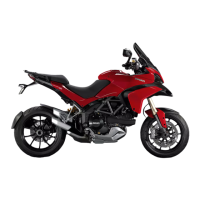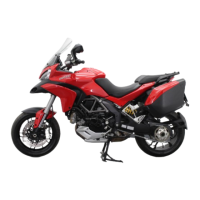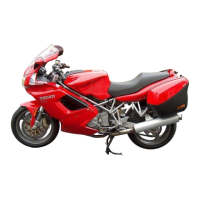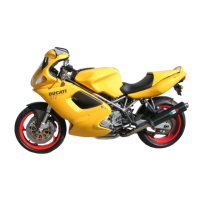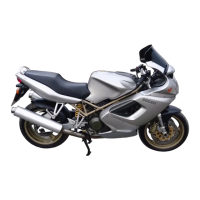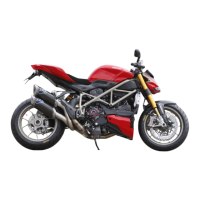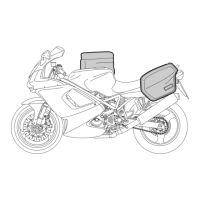Do you have a question about the Ducati ST4S ABS and is the answer not in the manual?
Details Ducati's warranty policy, coverage, and exclusions for motorcycles.
Explains the meaning of special remarks and icons used in the manual.
Provides essential safety guidelines and precautions for operating the motorcycle.
Specifies the motorcycle's load capacity and weight distribution guidelines.
Locates and explains the motorcycle's frame and engine identification numbers.
Illustrates the location and labeling of all motorcycle controls for easy identification.
Describes the gauges, indicators, and warning lights on the motorcycle's dashboard.
Explains the functions and readings of the motorcycle's digital display unit.
Details the anti-theft immobilizer system and its operation.
Describes the different types of keys provided and their functions.
Explains the importance and use of the code card for emergency situations.
Guides on how to operate the motorcycle, including starting and stopping procedures.
Provides instructions on how to obtain and program duplicate keys.
Explains the functions of the ignition switch positions and the steering lock.
Details the functions of the controls on the left handlebar switch assembly.
Describes the operation and importance of the clutch lever for smooth riding.
Explains the use of the cold start lever for starting a cold engine.
Details the functions of the controls on the right handlebar switch assembly.
Describes how to use the throttle twistgrip to control engine speed.
Explains the operation of the front brake lever and its hydraulic system.
Describes the operation of the rear brake pedal and its hydraulic system.
Explains how to use the gear change pedal to shift gears.
Provides instructions on adjusting the gear and brake pedals for rider comfort.
Identifies the main components and their positions on the motorcycle.
Details the operation of the fuel tank filler plug for opening and closing.
Explains how to use the seat catch and the helmet fastening hooks.
Provides instructions on using and parking the motorcycle with the side stand.
Describes the function of the lifting handgrip for maneuvering the motorcycle.
Details the location and use of the 12V power outlet for accessories.
Provides instructions on using the centre stand for parking the motorcycle.
Explains the design and features of the motorcycle's rear view mirrors.
Details how to adjust the front fork's rebound and compression damping.
Explains how to adjust the rear shock absorber's damping and spring preload.
Provides guidelines for the initial break-in period of the new motorcycle.
Outlines essential checks to perform before riding the motorcycle for safety.
Guides on the correct procedure for starting the motorcycle's engine.
Explains the steps for safely moving the motorcycle from a standstill.
Provides instructions on effective and safe braking techniques.
Details the Anti-Lock Brake System (ABS) and its operation.
Guides on how to safely stop the motorcycle and switch off the engine.
Provides instructions on how to properly park the motorcycle.
Details the procedure for refueling the motorcycle safely and correctly.
Describes the location and contents of the motorcycle's tool kit and accessories.
Explains how to remove and refit the motorcycle's fairing for servicing.
Provides information on fitting the optional side panniers to the motorcycle.
Details Ducati's warranty policy, coverage, and exclusions for motorcycles.
Explains the meaning of special remarks and icons used in the manual.
Provides essential safety guidelines and precautions for operating the motorcycle.
Specifies the motorcycle's load capacity and weight distribution guidelines.
Locates and explains the motorcycle's frame and engine identification numbers.
Illustrates the location and labeling of all motorcycle controls for easy identification.
Describes the gauges, indicators, and warning lights on the motorcycle's dashboard.
Explains the functions and readings of the motorcycle's digital display unit.
Details the anti-theft immobilizer system and its operation.
Describes the different types of keys provided and their functions.
Explains the importance and use of the code card for emergency situations.
Guides on how to operate the motorcycle, including starting and stopping procedures.
Provides instructions on how to obtain and program duplicate keys.
Explains the functions of the ignition switch positions and the steering lock.
Details the functions of the controls on the left handlebar switch assembly.
Describes the operation and importance of the clutch lever for smooth riding.
Explains the use of the cold start lever for starting a cold engine.
Details the functions of the controls on the right handlebar switch assembly.
Describes how to use the throttle twistgrip to control engine speed.
Explains the operation of the front brake lever and its hydraulic system.
Describes the operation of the rear brake pedal and its hydraulic system.
Explains how to use the gear change pedal to shift gears.
Provides instructions on adjusting the gear and brake pedals for rider comfort.
Identifies the main components and their positions on the motorcycle.
Details the operation of the fuel tank filler plug for opening and closing.
Explains how to use the seat catch and the helmet fastening hooks.
Provides instructions on using and parking the motorcycle with the side stand.
Describes the function of the lifting handgrip for maneuvering the motorcycle.
Details the location and use of the 12V power outlet for accessories.
Provides instructions on using the centre stand for parking the motorcycle.
Explains the design and features of the motorcycle's rear view mirrors.
Details how to adjust the front fork's rebound and compression damping.
Explains how to adjust the rear shock absorber's damping and spring preload.
Provides guidelines for the initial break-in period of the new motorcycle.
Outlines essential checks to perform before riding the motorcycle for safety.
Guides on the correct procedure for starting the motorcycle's engine.
Explains the steps for safely moving the motorcycle from a standstill.
Provides instructions on effective and safe braking techniques.
Details the Anti-Lock Brake System (ABS) and its operation.
Guides on how to safely stop the motorcycle and switch off the engine.
Provides instructions on how to properly park the motorcycle.
Details the procedure for refueling the motorcycle safely and correctly.
Describes the location and contents of the motorcycle's tool kit and accessories.
Explains how to remove and refit the motorcycle's fairing for servicing.
Provides information on fitting the optional side panniers to the motorcycle.
| Displacement | 996 cc |
|---|---|
| Fuel System | Electronic fuel injection |
| Transmission | 6-speed |
| Frame | Tubular steel trellis |
| Rear Suspension | Progressive linkage with fully adjustable Showa monoshock |
| Engine Type | 4 valves per cylinder |
| Power | 117 hp @ 8750 rpm |
| Front Suspension | Showa 43 mm upside-down fully adjustable fork |
| Front Brakes | 2 x 320 mm discs, 4-piston calipers, ABS |
| Rear Brakes | 245 mm disc, 2-piston caliper, ABS |
| Fuel Capacity | 21 L |
| Seat Height | 820 mm |
| Wheelbase | 1430 mm |
| Torque | 98 Nm @ 7250 rpm |
